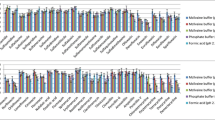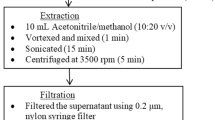Abstract
In poultry farming, anticoccidial drugs are widely used as feed additives for the prevention and treatment of coccidiosis. Because coccidiostats and veterinary medicines, in general, are often poorly absorbed, manure from treated animals may contain high concentrations of these compounds. Experimental studies have shown that the uptake of veterinary medicines by plants from soil containing contaminated manure may occur. This leads to several questions regarding the impact on the environment, resistance problems, and public health and allergy issues. This work describes the development of a quantification method for coccidiostats in vegetables. Vegetables were spiked at 100 μg kg−1 (dry weight) with coccidiostats (monensin, narasin, lasalocid A, salinomycin, diclazuril, and nicarbazin) in order to optimize the extraction and clean-up. Possible critical factors (e.g., extraction solvent) were statistically examined by linear regression with the use of Plackett–Burman and full factorial designs. Final extracts were analyzed with ultra-performance liquid chromatography tandem mass spectrometry operating in multiple-reaction monitoring mode. Both the synthetic and ionophoric coccidiostats could be determined in a single run with an analysis time of 5 min. The developed method was validated taking into account the requirements of the Commission Decision 2002/657/EC as a guideline. The method is regarded as applicable for its intended purposes with quantification limits between 0.30 and 2.98 μg kg−1. This method could be used to establish possible maximum residue limits for coccidiostats in vegetables, as already exist for eggs, meat, and milk.

Chromatogram of a 10 μg kg−1 spiked, freeze-dried carrot sample; X: Carrot-specific interference in the channel of dinitrocarbanilide (DNC); A: DNC; B: diclazuril; C: monensin; D: lasalocid A; E: salinomycin; F: narasin



Similar content being viewed by others
References
Kools SA, Moltmann JF, Knacker T (2008) Estimating the use of veterinary medicines in the European Union. Regul Toxicol Pharmacol 50(1):59–65
EMEA CVMP (1998) Clazuril summary report. EMEA/MRL/371/98-FINAL. Available at http://www.ema.europa.eu/docs/en_GB/document_library/Maximum_Residue_Limits_-_Report/2009/11/WC500012561.pdf
Sarmah AK, Meyer MT, Boxall AB (2006) A global perspective on the use, sales, exposure pathways, occurrence, fate and effects of veterinary antibiotics (VAs) in the environment. Chemosphere 65(5):725–759
Commission Regulation No. 1831/2003/EC (2003). On additives for use in animal nutrition. Off J Eur Commun
Council Regulation (EEC) No. 2377/90 (1990). Laying down a community procedure for the establishment of maximum residue limits of veterinary medicinal products in foodstuffs of animal origin. Off J Eur Commun
Boxall AB, Fogg LA, Kay P, Blackwel PA, Pemberton EJ, Croxford A (2003) Prioritisation of veterinary medicines in the UK environment. Toxicol Lett 142(3):207–218
Dorne JL, Fernández-Cruz ML, Bertelsen U, Renshaw DW, Peltonen K, Anadon A, Feil A, Sanders P, Wester P, Fink-Gremmels J (2011). Risk assessment of coccidostatics during feed cross-contamination: animal and human health aspects. Toxicol Appl Pharmacol (in press)
Donoho AL (1984) Biochemical studies on the fate of monensin in animals and in the environment. J Anim Sci 58(6):1528–1539
Sassman SA, Lee LS (2007) Sorption and degradation in soils of veterinary ionophore antibiotics: monensin and lasalocid. Environ Toxicol Chem 26(8):1614–1621
Zižek S, Hrženjak R, Kalcher GT, Srimpf K, Semrov N, Zidar P (2011) Does monensin in chicken manure from poultry farms pose a threat to soil invertebrates? Chemosphere 83(4):517–523
Kim SC, Carlson K (2007) Temporal and spatial trends in the occurrence of human and veterinary antibiotics in aqueous and river sediment matrices. Environ Sci Technol 41(1):50–57
Davis JG, Truman CC, Kim SC, Ascough JC 2nd, Carlson K (2006) Antibiotic transport via runoff and soil loss. J Environ Qual 35(6):2250–2260
Kim SC, Carlson K (2007) Quantification of human and veterinary antibiotics in water and sediment using SPE/LC/MS/MS. Anal Bioanal Chem 387(4):1301–1315
Song W, Ding Y, Chiou CT, Li H (2010) Selected veterinary pharmaceuticals in agricultural water and soil from land application of animal manure. J Environ Qual 39(4):1211–1217
Ramsey ED, Rees AT, Wei G, Liu JY, Wu XH (2010) Direct aqueous supercritical fluid extraction coupled on-line with liquid chromatography-tandem mass spectrometry for the analysis of polyether ionophore antibiotics in water. J Chromatogr A 1217(20):3348–3356
Martínez-Villalba A, Moyano E, Galceran MT (2009) Fast liquid chromatography/multiple-stage mass spectrometry of coccidiostats. Rapid Commun Mass Spectrom 23(9):1255–1263
Boxall AB, Johnson P, Smith EJ, Sinclair CJ, Stutt E, Levy LS (2006) Uptake of veterinary medicines from soils into plants. J Agric Food Chem 54(6):2288–2297
Jones-Lepp TL, Sanchez CA, Moy T, Kazemi R (2010) Method development and application to determine potential plant uptake of antibiotics and other drugs in irrigated crop production systems. J Agric Food Chem 58(22):11568–11573
Dolliver H, Kumar K, Gupta S (2007) Sulfamethazine uptake by plants from manure-amended soil. J Environ Qual 36(4):1224–1230
Kumar K, Gupta SC, Baidoo SK, Chander Y, Rosen CJ (2005) Antibiotic uptake by plants from soil fertilized with animal manure. J Environ Qual 34(6):2082–2085
Advisory committee on animal feedingstuffs. Discussion paper “European Commission review of the regulation of coccidiostats and histomanostats as feed additives—update” of 11 September 2007
Commission Decision No. 2002/657/EC (2002). Concerning the performance of analytical methods and the interpretation of results. Off J Eur Commun
Dubreil-Chéneau E, Bessiral M, Roudaut B, Verdon E, Sanders P (2009) Validation of a multi-residue liquid chromatography-tandem mass spectrometry confirmatory method for 10 anticoccidials in eggs according to Commission Decision 2002/657/EC. J Chromatogr A 1216(46):8149–8157
Mortier L, Huet AC, Charlier C, Daeseleire E, Delahaut P, Van Peteghem C (2005) Incidence of residues of nine anticoccidials in eggs. Food Addit Contam 22(11):1120–1125
Dai SY, Herrman TJ (2010) Evaluation of two liquid chromatography/tandem mass spectrometry platforms for quantification of monensin in animal feed and milk. Rapid Commun Mass Spectrom 24(10):1431–1438
Rokka M, Peltonen K (2006) Simultaneous determination of four coccidiostats in eggs and broiler meat: validation of an LC-MS/MS method. Food Addit Contam 23(5):470–478
Vincent U, Ezerskis Z, Chedin M, von Holst C (2011) Determination of ionophore coccidiostats in feeding stuffs by liquid chromatography-tandem mass spectrometry. Part II. Application to cross-contamination levels and non-targeted feed. J Pharm Biomed Anal 54(3):526–534
Olejnik M, Szprengier-Juszkiewicz T, Jedziniak P (2009) Multi-residue confirmatory method for the determination of twelve coccidiostats in chicken liver using liquid chromatography tandem mass spectrometry. J Chromatogr A 1216(46):8141–8148
Guidance for the use of repeatability, reproducibility and trueness estimates in measurement uncertainty estimation. ISO/TS 21748:2004
Acknowledgments
We are grateful to the European Food Safety Authority (EFSA) for the project funding (CFP/EFSA/CONTAM/2010/02). This paper is produced by the bodies identified above as authors; it is not produced by EFSA. EFSA reserves its right, view, and position as regards the issues addressed and conclusions reached in the present document, without prejudice to the rights of the authors.
Author information
Authors and Affiliations
Corresponding author
Rights and permissions
About this article
Cite this article
Broekaert, N., Van Peteghem, C., Daeseleire, E. et al. Development and validation of an UPLC-MS/MS method for the determination of ionophoric and synthetic coccidiostats in vegetables. Anal Bioanal Chem 401, 3335–3344 (2011). https://doi.org/10.1007/s00216-011-5433-1
Received:
Revised:
Accepted:
Published:
Issue Date:
DOI: https://doi.org/10.1007/s00216-011-5433-1




